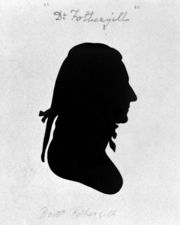Anthony Fothergill (Silhouette)
Created: 1804
Origin/Purchase: Philadelphia
Materials: paper embossed "Peale"
Dimensions: 7.6 × 5.4 (3 × 2 1/8 in.)
Location: Library (Book Room)
Provenance: Charles Willson Peale; by gift to Thomas Jefferson; by descent to Virginia and Nicholas Trist; by descent to Charles, James, and John Eddy; by gift to the Thomas Jefferson Memorial Foundation in 1962
Accession Number: 1962-1-18
Historical Notes: For more information on Fothergill, see the article on Alexander von Humboldt.
Further Sources
- Dictionary of National Biography, s.v. "Fothergill, Anthony (bap. 1737, d. 1813), physician."
- Lawrence, Christopher, Paul Lucier, and Christopher C. Booth. "'Take Time by the Forelock': The Letters of Anthony Fothergill to James Woodforde, 1789-1813." Medical History. Supplement 17 (1997): 3-109. An introduction to the article, including a biographical sketch of Fothergill, is available online.
